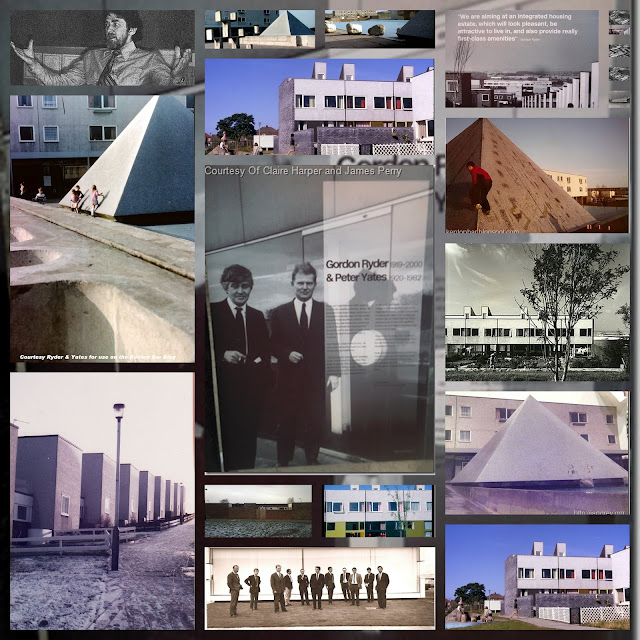Brothers did we miss this or am I going senile?
In our excitement at seeing the apex of The Pyramid in this picture did we forget to look at the rest of it? As you can see there is a full-blooded picture of the map too. And – take note Mr. Jolyon Yates – a very tiny picture of the disc shaped black and white street light I mentioned in my email to you!!!
I hope I am not going senile……



I hope I am not going senile……





Photo 35 in the KBEABFTP collection has an excellent lamppost.
ReplyDeleteI also missed the map the first time round.
excellent...sometimes one doesn't see the trees for the wood...
ReplyDeleteShades - you are right it is an excellent lamp post picture BUT it is not one of the disc lamp posts that I outlined. This is a modern one....
ReplyDeleteAh, I see what you mean. Were they white (Mercury)or yellow (Sodium) when lit?
ReplyDeleteI vaguely recall the Hazeldene Avenue perimeter road being yellow and the walkways being white but I could be mistaken.
Around the pyramid, they were all white fluorescent tubes, whether the large ones on the flats, the small ones set into the walls and the tiny ones at foot level along the ramp.
Nonsense-shades is right re:Photo 35 in the KBEABFTP...if you are on about the one next to the map then shades was not on about that one...more.it is not 'modern' in that it is one of the Hazeldene Ave ones from 20 years ago-the one's GOM was on about that could be disabled by 2 snowballs:
ReplyDelete1:Hit plastic cover of streetlight with snowball and it immediately popped open, hanging...
2.Throw second snowball at naked bulb, which smashes turning streetlight off rendering it useless.
I don get you anonymous - re we talking about the same picture - THIS one - hit the word THIS in blue
ReplyDeleteIf I recall correctly the street lights on the interior were originally mercury vapour. The ones on Hazeldene and on the Ponteland Road were sodium. In the mid-late 70s there was a mixture of the black/white disc streetlights and the type shown in picture 35. But the latter were by far the majority. Anon June 11 09:13 is correct in one aspect, there was a later sort of lantern similar to the one in pic 35 but it was noticeably more taller than it was wide (and was sodium vapour).
ReplyDeleteA final observation - it seems strange the council would instal different sorts of street lights. Were the black and white discs the original ones?
Andrew - good observations. I think the disc ones were the original and yes they threw a milky white mercury light instead of the horrible yellow sodium light. I really likes the disc lights but I guess like all thing they were too expensive to replace once they had been slug-gunned (not guilty m'lord.......:)), had stones and snowballs blasted at them for years on end etc. etc. I wish I could get a better picture of one of them though. You got any pics of Kenton Bar you might want to contribute to the blog?
ReplyDeleteIf I remember correctly, the diffuser was very translucent (frosted glass or probably plastic) so that you couldn't identify the lamp source within. The later narrower ones weren't really frosted, they just broke up the light source via ribbing.
ReplyDeleteFeast your eyes at Streetlightonline.
Could it have possibly been this one?
(The streetlights in action in Yorkshire)
ReplyDeleteCorrection, Derbyshire, not Yorkshire. (A different Normanton to the one I assumed).
ReplyDeleteBy jove I think you have it Dear Shades. How in the world did you find a site about street lights?
ReplyDeleteI will post the pics to the blog after I get permission from the site owner
How did I find it? Google is my friend...
ReplyDeleteThe CU Phosco 178- such a catchy name! ;-)
They are still going- www.cuphosco.com.
By the way, I used to work for a stage lighting Company and discovered (by accident) that the Local Authorities generally used to specify and commission street lighting, before the days of outsourcing and private finance initiatives. On this basis, it might have not been up to our friends at Ryder & Yates (but I imagine that Peter & Gordon had an opinion).
Reading the Phosco Company history, they used to specialise in concrete columns but I'm pretty sure the Kenton posts were circular steel (wider at the bottom where the fuse & time clock were behind the locked panel).
ReplyDeleteThat is not to say that they didn't supply the lanterns, or perhaps another manufacturer had a similar design. Did they have a knob on the top for internal access, I wonder?
My house is on there top of ryal walk
ReplyDelete